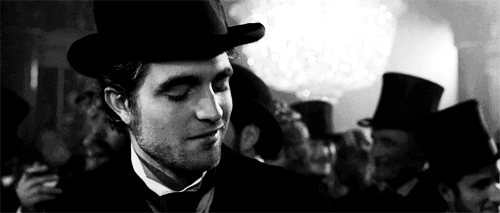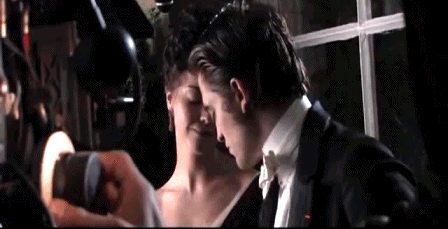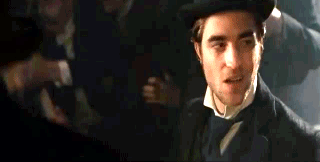#CREDIT TO BEL AMI
Explore tagged Tumblr posts
Text







Title: GOODBYE KISSES
Subtitle: MICK LOVELL'S LAST MOVIE
Models: MICK LOVELL KEVIN WARHOL
©️BEL AMI STUDIOS
#THE KISSING CHRONICLES 3#CREDIT TO BEL AMI#MICK LOVELL'S LAST MOVIE#SOFT GENTLE KISSES#CONNECTIONS AFTER A DATE SCENARIO#REVISITING DVD COLLECTION#PASSIONS IGNITE#My GIFS#MYGIFSET#MY-GIF-EDIT#LGBTQIA
104 notes
·
View notes
Text

THE PRIVATE AFFAIRS OF BEL AMI (1947): Acerbic but slow-moving and overly sanitized adaptation of an 1885 Guy de Maupassant novel about the rise and fall of perennial cad Georges Duroy (George Sanders), who becomes a prominent gossip columnist with the help of an old friend (John Carradine) and then marries the friend's widow (Ann Dvorak) — who's more or less writing his column — while spurning the love of another widow (Angela Lansbury) in his pursuit of power and position. There are about a half-dozen excellent scenes and some good supporting performances, but it goes on way too long and suffers badly from period censorship, culminating in a contrived tragic ending (not present in the book) where Georges sacrificially repents his wickedness. Paradoxically, making Georges less wicked than in the book also makes him more unpleasant to watch; only occasionally given the opportunity to be entertainingly ruthless, Sanders still makes Georges such a frosty, misanthropic (and misogynistic) asshole that it's hard to credit that he has any friends or lovers to betray. VERDICT: Has its moments, but Sanders is not very pleasant company, even for a movie that frankly describes itself as "The History of a Scoundrel."
#movies#hateration holleration#the private affairs of bel ami#albert lewin#george sanders#angela lansbury#ann dvorak#john carradine#warren williams#guy de maupassant#bel ami
6 notes
·
View notes
Text
faut rendre a cesar ce qui (€) appartient a cesar
Ainsi de 9.000.000.000€ post paria ... av. Les 8th de final 2020
Laurent Wauquiez a repercuter 3X la somme il nous doit la moitier de la somme fixer a < ~ > 13.000.000.000 € par le biais des maisons de campagne en marbre exterieur ou la salle de bain en marbre et le lavabo... il a construit 3 boites de nuit dont une avec restaurant fetes 18 ans auzances . . . Une a clermont ferrand et une a limoges .... refait une cathedrale nommer la cathedrale de saint jacques de compostelle ...
Parfait une autoroute jusqu' a lourdes et saint pe de bigore ( esp ) national N?
Avoir vendu les parts a de vinci pour des sous qui repartent sur la propreter des autoroutes ...
Bref il s' est bien demerder et il lui reste < ~ > 15.000.000.000€ ... c' est pour les regions centre auvergne descente en kayak etc... amusez vous bien et penser tjrs Sam c' est celui qui ne boit pas qui conduit et se comporte comme Capitaine de soiree des grd freres a leurs petite soeurs exemple (???)
Merci du soutient que tu m' as offert 100.000$ a noel pour un repas priver et rentrant les 96 avec une bouteille de vin a noel orthodoxe le 6 et 7 janvier ... j' adore ton (mon) clash a zuckerman : il n' y a que la verite qui bless ...
V. EXPLIQUES LUI LE PROCEDER DU PROG.
Soit 4.000.000.000$ sur de ta part ... (+) de 11.000.000.000 € dans vos caisses ... pensez a la confiture cuite aux chaudrons ok... stop fromagere ... mme devosge la laitiere elle y a mis du chocolat pot la laitiere ok... merci consoeur ... un confrere de (+) Golden pomme goldenberg apple juice austria ... bien ouej le credit apporter dont vs avez multiplier par 2 voila un bon point chacun 2nde part la votre soyez contents personne ne vous en veut !!!
Giorgia solo per vostro partito il nero fascismo ... il duce ... bel- ami cantica d' angelica .... delicio dei angeli immortale e .... chess master il totale a 18 € 5 decors per l' impressione 13€ albergho di vilacardi 600.000.000 € porta garibaldi stazione di treno fermata milano... inter media oak tree 500.000.000$
Renault alpine bwt F1 team ... 3.4 md da 2020... qualcosa vicino a ! Che risolve a piu' di 5.000.000.000$ benetton lutte contre les discrimations raciales et pas ceux du meme sexe ... une abomination paradoxale !!!
3 notes
·
View notes
Photo


Georges Duroy // Bel Ami (2012) (credit to the gif maker)
34 notes
·
View notes
Text
German powerhouse Beta Cinema has boarded world sales on Nowhere Special, the upcoming drama from director Uberto Pasolini.
Now shooting in Belfast, Northern Ireland, the film stars James Norton as thirty-five-year-old window cleaner John, who has dedicated his life to bringing up his son after the child’s mother left them soon after the birth. When John is given a few months to live, he attempts to find a new family for his child.
Multi-hyphenate Pasolini also wrote the screenplay and serves as the main producer on the project. The filmmaker’s previous credits include producing The Full Monty and Bel Ami.
As a director, Pasolini’s last feature was 2013 drama Still Life with Eddie Marsan and Joanna Froggatt. Beta also collaborated with the director on that film - which premiered in Venice’s Orizzonti section in 2013 and secured releases in countries including US, UK, Australia and New zealand, Italy, Germany, France, Benelux, Japan, and Korea – as well as Pasolini’s 2008 feature Machan, which was also at Venice.
Nowhere Special is a UK-Italy-Romania co-production between Picomedia SRL, Nowhere Special Ltd, Avanpost/Digital Cube SRL, in association with Rai Cinema, with the support of Northern Ireland Screen and Eurimages.
“Still Life was a particularly joyful collaboration with many deserved awards and numerous sales and, most importantly, successful releases in many territories. We feel that Nowhere Special has a similar tone, but may be even more accessible,” commented Beta’s Thorsten Ritter.

30 notes
·
View notes
Text
24 Years Later TICKS Continues to Latch Onto Horror Fans
Ants in Them (1954), bees in The Swarm (1978), and cockroaches in Mimic (1997), the insect subgenre of horror goes back decades and is showing no sign of slowing down. Long before movies like Stung (2015) could be found streaming on Netflix, there was another small horror flick that was a fan favorite amid the direct-to-video horror craze of the 1990s. This May, Ticks is celebrating its twenty-fourth anniversary. Like the one word title, the film’s official synopsis via Google is simple and to the point: “Teenage campers and their chaperones encounter a horde of bloodthirsty mutated ticks.” IMO, with that title and synopsis, how can you go wrong?
The Cast and Crew
Ticks stars Ami Dolenz, Seth Green, Rosalind Allen, Clint Howard, and The Fresh Prince of Bel-Air‘s Alfonso Ribeiro in his feature film debut. For the majority of movie goers, Seth Green is probably the most recognizable cast member, as he went on to appear in a string of major studio films during the 1990s (Can’t Hardly Wait, the Austin Powers franchise, and Idle Hands, to name a few) and landed the role of Oz on TV’s Buffy the Vampire Slayer. Despite the current name recognition of Seth Green, Ticks was released before he became a well known actor. In 1994, Ami Dolenz was the name that horror fans gravitated toward. Dolenz appeared in several horror films during the early part of the 90s and seemed to be on the brink of becoming a breakout star. In addition to Ticks, Dolenz starred in and Children of the Night (1991), Witchboard 2: The Devil’s Doorway (1993), and Pumpkinhead 2: Bloodwings (1994). Dolenz and Green’s Ticks co-star, Rosalind Allen, is also no stranger to genre fare. Prior to Ticks, Allen starred in Children of the Corn 2: The Final Sacrifice (1993) and To Die For 2 (1991). Clint Howard, brother of actor/producer/director Ron Howard, has had a long career of appearing in both lower budget fare as well as mega budget Hollywood productions. For example, The Ice Cream Man and Apollo 13 were both released in the same year, 1993.
It’s not just the actors where genre fans will find interest. Ticks has recognizable horror talent both in front of and behind the camera. The film was directed by Tony Randel of Hellbound: Hellraiser II (1988) fame, Amityville 1992 (1992), and Children of the Night (1991). The special effects for Ticks was led by Doug Beswick who had previously worked on such high profile titles as Ghostbusters (1984), A Nightmare on Elm Street 3: Dream Warriors (1987), and Darkman (1990).
Marketing
Leading up to the May 25 VHS release date, Ticks had a lot going in its favor. In addition to the horror-friendly cast and crew and flashy VHS box art that featured a screaming close-up of Ami Dolenz being surrounded by the titular creatures, Ticks also appeared on the cover of Fangoria magazine. Here, the film took precedence over two Stephen King adaptations, Needful Things and Tommyknockers, both of which got side-panel placement in comparison to the gory full page image of Ticks.
While researching this article, I came across a cool marketing video for Ticks. The video was attached to screeners that were sent to movie rental stores prior to the release date as a way to convince store owners that they should purchase copies of the film for their shelves. The promo reel pushes the film’s special effects, star Ami Dolenz, and the “bug” factor as the major selling points. In addition to receiving a cool 5′ Ticks standee and shelf talkers, the video offers several other marketing ideas that would “keep your store infested with horror fans”, including setting up a blood drive that would give a free rental of Ticks to anyone donating a pint of blood that day.
youtube
Is It Any Good?
Ticks was released straight to video on May 25, 1994. Let’s keep in mind that the fact of movies (horror especially) skipping past any type of theatrical release wasn’t necessarily a bad thing; VHS horror was hot during the decade, and Ticks was aimed to give horror fans specifically what they wanted in the form of giant mutated insects wrecking havoc on a group of teen campers.
The Acting
For me, the standout performance of Ticks goes to Ami Dolenz. In the film, Dolenz stars as Dee Dee Davenport, one of the group of troubled teens who, along with their social workers, ventures into the woods. Based on her performance in Ticks, Dolenz proves to be a capable and likable horror actress. As mentioned earlier, she appeared in several other horror flicks around the same time as Ticks. These days, it seems that Dolenz is taking a break from acting. According to IMDB, her most recent credited film role was in 2010’s House Rules for Bad Girls. Personally, I would like to see Dolenz make a return to the screen. With all of the 90s nostalgia in full swing at the moment, I could easily imagine her playing the mother character to a new generation of teen horror stars.
The Cinematography and Effects
In addition to Dolenz’s recognizable on-screen presence, the promise of gooey and gorey special effects is what caught the attention of most horror fans and was reason enough for us to tune in. I mean, let’s face it, this kind of movie is obviously not for everybody. When you commit yourself to watching a movie about mutated, bloodthirsty ticks, what do you want to see? Well, I’m happy to report that the practical effects on display in Ticks will deliver. Just take a look at the trailer and the promo reel and you’ll get an idea of the fun ride that the movie promises.
Reception
For horror fans, Ticks was a video store staple through the 90s. Over the years, the film has gained a small following. With only 6 critic reviews on Rotten Tomatoes, Ticks currently has a “fresh” score of 67%. As far as purchasing goes, a copy of the film is hard to come by. On Amazon, the price of the DVD starts at a whopping $79.99 and goes up to double that amount (!) for a Blu-ray.
I like to think that Ticks has made a lasting impression on the insect subgenre of horror. Are you a fan? Let us know in the comments below or on Twitter, Instagram, Reddit, and in the Horror Fiends of Nightmare on Film Street Facebook group!
The post 24 Years Later TICKS Continues to Latch Onto Horror Fans appeared first on Nightmare on Film Street - Horror Movie Podcast, News and Reviews.
from WordPress https://nofspodcast.com/24-years-later-ticks-continues-to-latch-onto-horror-fans/ via IFTTT
1 note
·
View note
Text
“Sono come Glenn Gould, per questo traduco Samuel Beckett e 007”: dialogo con Massimo Bocchiola
Forse, mi dico, capita come in un racconto di Borges. Il traduttore – compito affine al sortilegio – mette una parolina in più lì, sega un aggettivo là. Microscopici smottamenti linguistici che cambiano la storia della letteratura. Una piccola pietra in mezzo al fiume crea tsunami, a valle. Massimo Bocchiola è tra i grandi traduttori italiani, oggi. Traduce dall’inglese. Per intenderci. Nello stesso mese, per Adelphi, sono uscite le Lettere di Beckett e Goldfinger, di Ian Fleming. La mano da gourmet del linguaggio è la sua. Io nutro una specie di venerazione per i traduttori. Perché? Perché lo stesso libro suona diverso sotto le mani di un traduttore o di un altro. Provare per credere. Penso di avere tutte le versioni italiane di Moby Dick e quelle dell’Idiota di Dostoevskij. Beh, a volte pare di leggere libri opposti, che si muovono a una diversa velocità linguistica.
Lui è Massimo Bocchiola. Tra i tantissimi, ha tradotto Samuel Beckett, Rudyard Kipling, Stevenson, Paul Auster, Pynchon
“Tradurre per mestiere mi ha fatto scrivere, direi quasi mio malgrado, pagine di una grandezza aliena a me stesso come autore. E mi ha lasciato nel ricordo, o appena sotto di esso, una moltitudine di passaggi memorabili, di metafore sfolgoranti, di ruvidi colloquialismi”, scrive Bocchiola in un bel libro sull’arte del tradurre, Mai più come ti ho visto, pubblicato da Einaudi nel 2015. Nello stesso anno licenziava, tra l’altro, lui, traduttore bulimico (“Se anche la mia carriera di traduttore di libri finisse in questo momento, avrei già composto tante pagine di letteratura – e tante pagine di splendidi libri – da pormi volumetricamente allo stesso livello dei grandi narratori ottocenteschi”), la nuova versione de L’isola del tesoro di Robert Louis Stevenson. Attraverso Bocchiola, che è anche poeta e scrittore (ricordo, almeno, Mortalissima parte e Il treno dell’assedio), che ha il radar del linguaggio conficcato nel cervello, leggiamo Thomas Pynchon (“Pynchon è uno di quegli scrittori che portano le parole e i loro nodi a una tensione estrema. Tuttavia non lo fa come Gadda, con un senso di orrore fisico per il mondo cui si oppone soltanto l’ossessione dell’ordine: ma con un sorriso diffuso sul volto”) e Rudyard Kipling, Paul Auster e Irvine Welsh, Martin Amis e Charles Bukowski e W.H. Auden (l’incommensurabile volume Adelphi delle Poesie scelte) e 007. Chissà. Zitto zitto. Limando un aggettivo. Tendendo un verbo. Bocchiola fa la storia della letteratura.
Novità Adelphi. Ora. Lettere di Samuel Beckett. Goldfinger di Ian Fleming. Stesso traduttore. Massimo Bocchiola. Come si fa a evitare la schizofrenia linguistica passando da Beckett a Fleming?
Domanda ottima. Rispondo per chiarezza con un esempio clamorosamente troppo illustre, Glenn Gould che predilige e alterna Gibbons, Bach e Schönberg.
Più in particolare. Come si fa a non perdere la propria lingua frequentando quella degli altri? Intendo. Tu sei – di tuo – scrittore, poeta. Come ha fatto la lingua di Bocchiola non essere annientata da quella degli svariati ‘giganti’ che hai tradotto?
In realtà è stata più costruita che annientata. Intendo dire la mia lingua in prosa (se c’è differenza da quella in versi, ma direi di sì). Può darsi invece che tradurre tutti questi grandi autori mi abbia annientato come scrittore di poesia, colpito dalla loro facilità comunicativa anche quando scrivono cose ardue o sperimentali – in confronto a una mia difficoltà comunicativa che la forma in versi non faceva che accentuare.
Perché a uno viene in mente di tradurre la lingua di un altro, di tanti altri, fino a farne un mestiere?
Qui devo proprio rispondere: nel mio caso, per caso. Lavoravo da qualche anno come collaboratore/consulente editoriale, ma facevo altro: redazione, letture. Siccome leggevo anche in inglese, a un certo punto mi hanno proposto delle piccole traduzioni, di librini per l’infanzia. È nata così.
Il libro che ti è piaciuto di più tradurre: qual è? O meglio. In quale linguaggio ti è piaciuto di più sguazzare?
Devo rispondere in due a pari merito (non a caso li traduco da un ventennio entrambi): Welsh e Pynchon. Chiunque vede che sono diguazzamenti diversi: nel caso di IW, spesso l’atto è letterale, in quanto lui allestisce un vero brago linguistico. Con la lingua di TP ho invece la presunzione di condividere un certo tipo di humour.
Esiste un libro che ti piacerebbe aver tradotto ma che non hai tradotto? O meglio. Esiste un libro che non avresti voluto tradurre, ma che…
Mah, faccio il traduttore per mestiere, quindi anche per pagnotta. Ho tradotto molti libri che non mi entusiasmavano, ma nel corso del lavoro ho sempre cercato di divertirmi. A volte è stata dura. Libro che mi piacerebbe non aver tradotto, ma tradurre, e chissà che non ci riesca: House mother normal, di BS Johnson.
Ora. Cosa stai traducendo? A cosa stai lavorando di ‘tuo’?
Attualmente al nuovo Welsh. Entro l’anno ci saranno anche il nuovo Bond (Thunderball) e un classico, Walden. Preciso che del Bond ho già fatto la prima stesura, altrimenti non avrei tempo abbastanza… Di mio, a maggio/giugno uscirà per il Saggiatore una raccolta di storie vere e inventate, Gli ultimi giorni di agosto. Prose abbastanza liriche, ma non sempre.
L'articolo “Sono come Glenn Gould, per questo traduco Samuel Beckett e 007”: dialogo con Massimo Bocchiola proviene da Pangea.
from pangea.news http://ift.tt/2IC9xcd
1 note
·
View note
Photo

Bonjour les amours ! ❤️ Plus que quelques jours pour profiter de l’offre exclusive de la rentrée : pour toutes précommande de notre nouvel album "Bel Inconnu", l'album "Effet mère" offert + goodies !!! Pour recevoir votre golden pack au prix exclusif de l'album "Bel Inconnu", rien de plus simple. Il vous suffit de pré-commander l'album physique simple en cliquant sur ce lien : https://melesyloe.bandcamp.com/album/bel-inconnu (ou cliquez sur le lien dans la bio) et on vous envoie le Golden Pack 🤩 ✨Offre valable jusqu'au 30 septembre 2020✨ ! Partagez en masse pour en faire profiter vos amis et famille 😘 Credit photo Bel Inconnu : Rêv'Elle Art Photographie, Effet Mère : Angie Mathé #album #belinconnu #duo #voix #pop #voice #piano #music #melesyloe #effetmere #musique https://www.instagram.com/p/CFZJBhEJWiV/?igshid=19xie7pxh8qxp
0 notes
Text
Zerzura: Az ősi elveszett szaharai oázis, amit fekete óriások őriztek
Amennyire képesek vagyunk visszaemlékezni, az embereket mindig is elbűvölte az ősi elveszett városok felfedezésének a lehetősége. Felfedezők keltek útra a legveszélyesebb expedíciókra, hogy az elveszett városok kincseit felkutassák, s olykor sikerrel is jártak.
Sok elveszett várost találtak már meg víz alatt, a sivatagban és a dzsungelben, de néhány rejtélyes ősi hely továbbra is a mitológia birodalmában maradt. Az a tény, hogy eddig nem találtuk meg őket, még nem jelenti szükségképpen azt, hogy nem léteznek.
Mítoszok és legendák szólnak a Szahara-sivatag rejtekén megbúvó ősi elveszett oázisról. Neve Zerzura és azt beszélik, hogy valahol mélyen az Egyiptomon vagy Líbián átkígyózó Nílus nyugati oldalán található.
Egy névtelen 15. századi arab kincskereső útikönyv, a Kitab al Kdnuz (Az elrejtett gyöngyök könyve) úgy említi Zerzurát, mint a sivatag egy fehér homokos városát, amelynek kapujába egy madarat véstek. Azt tanácsolják a kincsvadásznak, hogy „vegye kézbe a madár csőrében található kulcsot, majd nyissa ki a város kapuját. Lépjen be és temérdek kincsre fog ott lelni…”
Az elveszett sivatagi város, amely „olyan fehér, mint a gerle”, s melyet gyakran a „Kis madarak oázisaként” is emlegetnek, egy alvó király és királyné nyughelye.
Bár egyes ókori szerzők szerint lehetetlen Zerzura felkutatása, léteznek olyan régi mítoszok, melyek elbeszélik, hogy az oázist olyan fekete óriások védelmezik, akik mindenkit megakadályoznak abban, hogy erre az enigmatikus helyre beléphessen és ott tartózkodhasson.
Nehézségekbe ütközik Zerzura eredetének kinyomozása. Hérodotosz, görög történetíró (Kr. e. 484-425) említ egy „Dionüszosz városaként” ismert legendás helyet, amely eltűnt a sivatag homokjába. Ez lehet akár Zerzurára való hivatkozás is.
Credit: Screenshot from Lost Chronicles of Zerzura
Az első európai hivatkozások Zerzurára John Gardner Wilkinsontól, egy angol egyiptológustól származnak, melyek a Théba topográfiája és Egyiptom általános képe című könyvében jelentek meg 1835-ben. Beszámolóját egy arab elbeszélésére alapozza, aki elmesélte, hogy egy oázisra lelt az egyik elveszett tevéjének keresése közben, azonban Wilkinson nem adta meg az elveszett oázis pontos helyét.
A felfedezők számos ismeretlen oázist találtak Willkinson említett könyvében, viszont magát a legendás Zerzurát nem fedezték fel.
Almásy László gróf, aki a magyar légierő egyik legjobb pilótája volt, hallott Zerzura mesébe illő, eltűnt oázisáról. Eltökélte, hogy megkeresi azt. 1932-ben az Almásy-Patrick Clayton expedíció felderítő repülései felfedeztek két völgyet Gilf Kebirbe, Líbia eldugott délkeleti és Egyiptom délnyugati sarkában található Új Völgy Kormányzóságának egyik fennsíkján.
Almásy három Zerzura vádit (sivatagi vízmosást, kiszáradt folyómedret) fedezett fel, de Almásy szisztematiks kutatásának dacára sem sikerült az elveszett város romjaira bukkanni eddig.
Mi változtatta a zöld Szaharát sivataggá?
Zerzura – a legendás város tele kincsekkel, valamint a maga alvó királyával és királynéjével – még mindig csupán mitikus helyként létezik. Vajon Zerzurát elnyelte a sivatag? Talán Zerzura sokkal idősebb, mint gondolnánk. Volt olyan idő a régmúltban, amikor a Szahara zöld volt. A tudósok felfedezték, hogy kb. 100 000 évvel ezelőtt ősi folyók zöld folyosókat alakítottak ki a Szaharán keresztül.
Lehetséges, hogy az elveszett város csakis az emberi képzeletben létezett. Jelenleg nem ismerjük az igazságot ezzel a lenyűgöző hellyel kapcsolatban.
Forrás / Original article: http://www.ancientpages.com/2018/01/29/zerzura-lost-ancient-sahara-oasis-guarded-black-giants/
Engedd meg, hogy figyelmedbe ajánljam a napvallás eseményeit!
Részletes eseménynaptárunkat itt találod: https://napvallas.hu/programnaptar/
Részt vehetsz programjainkon:
Istentiszteletek http://napvallas.hu/programok/tudj-meg-tobbet-az-istentiszteletekrol-es-ami-mogottuk-van/Aurafejlesztő és Meditációs Klubok http://napvallas.hu/programok/aurafejlesztoi/Főnix-programok http://napvallas.hu/programok/fonix-pHYPERLINK “http://napvallas.hu/programok/fonix-program/”rogram/Egómentesítő kurzusok http://napvallas.hu/programok/egomentesito-kurzus/Karma Oldó Napok http://napvallas.hu/programokHYPERLINK “http://napvallas.hu/programok/karma-oldo-nap/”/karma-oldo-nap/Szer-napok (szent ünnepnapjainkon) https://www.facebook.com/napvallas/?fref=tsÉbresztő Táborok https://napvallas.hu/programok/holisztikus-tabor/Bel- és külföldi zarándoklatok https://www.facebook.com/napvallas/?fref=tsÍzisz Napjai https://napvallas.hu/programok/izisz-napjai/
Csatlakozz hozzánk minden elkötelezettség nélkül!
Járd velünk együtt önmagunk felszabadításának útját, melynek segítségével egységet teremthetsz önmagadban és a környezetedben, s hozzájárulhatsz a világ rendjének helyre állításához!
Száraz György
Boldog napot!
The post Zerzura: Az ősi elveszett szaharai oázis, amit fekete óriások őriztek appeared first on Boldognapot.hu.
Zerzura: Az ősi elveszett szaharai oázis, amit fekete óriások őriztek a Nemzeti.net-en jelent meg,
1 note
·
View note
Text
La regina dell’aria: Amy Johnson

Fa così freddo che ha paura di respirare. Se quest'aria glaciale le entrasse dentro, tutta in una volta, potrebbe ucciderla. Il cuore, il suo piccolo animale cardiaco, che le ha nidificato in seno, sceglierebbe di andarsene in letargo. La lascerebbe sola, a fluttuare nel nulla più gelido di sempre, ancora per qualche frigido istante, prima di schiantarsi definitivamente. Finirebbe così, finirebbe male, con un assurdo percorso a ritroso: dal regno dei cieli all'impatto col suolo. Niente rimarrebbe di lei, fuorché il biasimo dei benpensanti. “Se l'è andata a cercare!” direbbero i più antipatici, liquidando come perniciosa follia la sua voglia di libertà. Amy trema come una foglia, sotto il pesante giubbotto di pelle, imbottito di peluria ovina, e sotto la tuta da aviatore, oramai completamente zuppa di pioggia. È così stanca che vorrebbe solo chiudere gli occhi e mollare tutto, lasciarsi andare al nulla e riposarsi, finalmente, nell'eterno niente che l'aspetta. “Quanto tempo mi rimane prima di assiderarmi completamente?” pensa Amy, un attimo prima di chiudere pericolosamente gli occhi. Per la prima volta, nei suoi 27 anni di vita, ha deciso di mollare. La morte le sembra la scelta più vantaggiosa, di fronte al gelo e alla stanchezza. Curiosamente, però, è proprio il suo corpo a salvarla. Il suo corpo prostrato e intirizzito, che le urla da giorni di smetterla subito con questa tortura insopportabile, le viene inaspettatamente in soccorso. Non appena inizia a battere i denti, infatti, Amy si morde involontariamente la mucosa della bocca, appena dietro le labbra. Il dolore pungente la risveglia dal suo pericoloso torpore. Amy riapre gli occhi e lancia la lingua contro la zona dolorante. Si impegna in una compressione palliativa che le possa donare sollievo al più presto. Non funziona. La bocca le duole ancora, tanto forte è stato il suo morso accidentale. Non le resta che imprecare ad alta voce. Altissima, anzi. Tanto chi mai potrebbe sentirla quassù? Ma il gioco è fatto: la sofferenza e la rabbia la hanno provvidenzialmente ridestata ed Amy può adesso riprendere il controllo di se stessa e dell'aereo. È la dimostrazione di come il dolore possa essere benefico e corroborante, qualora si abbia il coraggio di affrontarlo a viso aperto. Amy riduce gli occhi a una fessura, ora che la rabbia ha soppiantato l'indolenza dovuta allo sfinimento. Manovra l'aereo in picchiata. Esso inizia a sussultare e a gemere come un animale ferito. Chiamarlo ancora aereo è un grande attestato di stima e, forse, una sopravvalutazione imperdonabile. Il termine più corretto sarebbe “trabiccolo". Meglio ancora “coso". Il coso, tutto squinternato da due settimane di volo singhiozzante, sballottato dalla tempesta monsonica, danneggiato da due atterraggi di fortuna, rattoppato alla bell’e meglio dagli indigeni (sedicenti meccanici), sarebbe un Havilland DH 60 Moth Gipsy. Amy lo ha comprato di seconda mano per 600 soffertissime sterline. Le sembravano soldi ben spesi, appena un mese fa. Se l'era fatto rimettere a nuovo, il coso, verniciandolo in due tonalità: un classico verde inglese e un rassicurante argento banausico. Lo aveva allestito al meglio per prepararlo alla sua folle impresa. Con la vernice fresca e i due serbatoi supplementari, sembrava aver acquisito un'insospettabile solidità, a fronte dei suoi soli 417 Kg di peso a vuoto e del modesto motore da 100 Hp. Il coso, infatti, è un modello degli anni ’20, un timido pioniere dell'aeronautica. Non offre né comodità né sicurezze, si muove per mezzo di un'elica, e traballa abbondantemente. Del resto, cosa ci si potrebbe aspettare da un velivolo al quale il costruttore ha dato il nome di “moth gipsy" (falena zingara)? Adesso la falena è azzoppata e l'intelaggio delle sue ali ha subito dei forti danni, cui si è cercato di porre rimedio in maniera fantasiosa e con quel poco che c'era a disposizione. In alcuni punti, si è provveduto a fasciare i tubi con bende e cerotti, visto che era impossibile procurarsi un saldatore. Il record, il tanto agognato obiettivo di ottenere un assurdo primato, è oramai sfumato. Non restano che il pericolo, la stanchezza e la delusione. Oh, di certo la conoscete tutti la delusione, la lama aguzza con cui il fallimento recide tutto il possibile, dentro l'animo dello sconfitto: la favella, per privarlo dell'espressione; la volontà, per fiaccarne l'ambizione; le energie, per minarne l'orgoglio. La delusione avvelena l'animo e rumina in testa in mille circoli viziosi e concentrici, che possono avvilupparsi all'infinito se non si reagisce in fretta. “Ne valeva la pena?” si chiede adesso Amy, mentre tenta un atterraggio di fortuna.

Amy Johnson Credit: @NationalGallery Era il primo giorno di luglio del 1903 quando Amy Johnson venne alla luce ad Hull, nella periferia inglese. Suo padre dovette sgranare gli occhi alla vista di colei che era la sua quarta figlia femmina e, in seguito, rassegnarsi a non avere un erede maschio. Ben presto, però, si accorse che il ruolo di maschiaccio della famiglia lo avrebbe assunto Amy. Un carattere esuberante e uno spirito libero si nascondevano dietro gli splendidi occhi azzurro cielo di sua figlia minore. Si manifestavano con la tendenza alla ribellione, con il rifiuto del conformismo e con una grande energia. Crebbe in fretta, Amy Johnson, e la genetica le regalò un bel volto cinematografico. Aveva uno sguardo profondo e penetrante, contornato da sopracciglia lunghe e sottili. Una naturale ombreggiatura delle palpebre e del contorno occhi contribuivano ad accentuare il magnetismo delle sue iridi, conferendole fascino ed alterigia. A soli 14 anni ebbe un fastidioso infortunio, che segnò uno spartiacque importante nel suo sviluppo emotivo. Durante una partita di cricket, la mazza di una maldestra giocatrice sfuggì ad ogni controllo e volò dritta in faccia ad Amy. Il dolore lancinante e il terribile spavento per la copiosa perdita di sangue dal naso e dalle labbra, la fecero tremare a lungo. Ma se la cavò con qualche punto di sutura e con la perdita di un incisivo. Se prima era loquace e ciarliera, dopo questo episodio divenne silenziosa ed introversa. Tendeva a starsene sola, a contemplare il mondo dalla sua prospettiva anticonformista. Sognava. Stava con la testa tra le nuvole, pur avendo allora i piedi piantati per terra, e aspirava a qualcosa che non avrebbe saputo definire. Lo avrebbe scoperto solo molto più tardi, il suo sogno arcano e sottaciuto: volare. Salire lì, dove tutto appare più puro ed appagante, dove nessuno interferisce con il suo spazio vitale e dove la libertà incontra meno ostacoli.

Amy Johnson da bambina Credit: @TheMirror Amy si appassionò al volo all'età di 25 anni. Si trovava a Londra, dove si era trasferita dopo aver conseguito la laurea in economia. Già un titolo di studio accademico era, a quell'epoca, un insolito distintivo di valore per una donna. Il fatto, poi, che non pensasse a cercarsi un marito, come facevano le sue coetanee e come avevano già fatto le sue sorelle maggiori, la rendeva quantomeno stramba agli occhi del mondo. Amy aveva deciso di lavorare e rendersi economicamente indipendente. Si era impiegata come segretaria in uno studio legale e si era subito fatta apprezzare per competenza e professionalità. Ma il desiderio di evasione, che aveva sempre covato inconsciamente, si era manifestato quando aveva visto una scuola di pilotaggio. I costi proibitivi, per quella che era allora un'attività avveniristica ed elitaria, la tennero lontana dalla tentazione per qualche tempo. Finché non scoprì che, iscrivendosi all'Aeroclub londinese, avrebbe potuto addestrarsi con spese molto più contenute. Era l'unica donna del corso, ma questo non la intimidì in nessun modo. Seguì scrupolosamente tutte le lezioni e cominciò ad impratichirsi su un piccolo aereo biposto, dotato di doppi comandi. Una scuola guida in aria, insomma. Quanta trepidazione nel sollevarsi da terra per la prima volta, e quanta bellezza dimostra di avere il mondo visto dall'alto, e quante emozioni nel sentire di avere il controllo del velivolo, senza che l'istruttore interferisca nelle manovre… Amy riuscì ad effettuare il suo primo volo in solitaria il 9 Giugno 1929. Un mese dopo ottenne il brevetto di volo. Ma continuò a studiare e ad esercitarsi, acquisendo molte competenze in ambito meccanico. Così, divenne la prima donna britannica ad ottenere un brevetto di ingegnere di terra. Era in grado, quindi, di effettuare da sola la manutenzione ordinaria di un velivolo. Il problema era che la passione per il volo le portava via molto tempo e le assenze dal lavoro divennero troppo frequenti. Il suo capoufficio le intimò di scegliere fra il lavoro e la sua voglia di volare. Amy si dimise e scelse di diventare un pilota professionista. Un mestiere da uomo per una donna risoluta e ambiziosa. Tanto per cominciare, scelse un obiettivo facile facile: una trasvolata intercontinentale dall'Inghilterra all'Australia. Si proponeva di battere il record che era stato stabilito nel 1928 da un pazzo di nome Bert Hinkler, che aveva completato il viaggio in quindici giorni e mezzo. Una robetta da niente, insomma. Il signor John William Johnson, suo padre, scuoteva la testa e sorrideva al sentire i propositi di quella sua figlia scapestrata. Ma non le negò il suo appoggio quando Amy gli chiese di contribuire all'acquisto di un aeroplano usato. La sorte gli aveva negato un figlio maschio, ma la sua Amy prometteva di dargli grandi soddisfazioni. All'investimento contribuì anche Charles Wakefield, petroliere e mecenate dell'aeronautica. La scelta si rivelò essere subito proficua, visto che la stampa si interessò immediatamente all'impresa che Amy stava progettando. Il Daily Mail si assicurò l'esclusiva per la cronaca delle varie tappe della trasvolata per la ragguardevole cifra di 2000 sterline. La compagnia di Wakefield fornì il carburante durante il viaggio. Bisogna considerare che quelli non erano tempi in cui si potevano facilmente reperire grossi quantitativi di benzina, specialmente nei paesi meno industrializzati. Trattandosi di una corsa contro il tempo, inoltre, bisognava effettuare le operazioni di rifornimento il più in fretta possibile, quindi i fusti di carburante dovevano essere già predisposti nei punti di atterraggio prestabiliti. Trovare e riconoscere tali avamposti era una vera e propria impresa. Non esistevano né radar né strumenti di navigazione satellitare, quindi bisognava procedere individuando via via dei punti di riferimento segnati sulle mappe. Il volo veniva effettuato a quote piuttosto basse, rispetto a quanto avviene oggi. Si trattava di qualcosa che era più facile a dirsi che a farsi. Questa benedetta donna, questa donna sconsiderata e avventurosa, che ha rischiato di morire di freddo, che ha dormito qualche notte all'addiaccio su terre sconosciute, con l'unico conforto di un sacco a pelo, che ha rischiato di schiantarsi al suolo o di sprofondare nell'oceano, aveva scelto di partire il 5 Maggio 1930. Vi pare il caso di intraprendere un simile viaggio in una data tanto funesta? Solo un'inglese poteva non curarsi di un tale dettaglio storico. Comunque, dopo il decollo dall'aeroporto di Croydon, le cose andarono piuttosto bene, se si eccettua qualche difficoltà diplomatica in Turchia, che la costrinse ad effettuare una tappa supplementare ad Aleppo, in Siria. Poi si diresse verso Baghdad ma, a causa di una violenta tempesta di sabbia, dovette avventurarsi ad atterrare sul terreno di un povero contadino, assolutamente ignaro. La Royal Air Force, di stanza in Iraq, effettuò le riparazioni indispensabili sul suo trabiccolo danneggiato ed Amy poté ripartire per Bandar Abbas (Iran) e Karachi (Pakistan). Era ancora in vantaggio sul tempo stabilito da Bert Hinkler prima di raggiungere l'India. L'atterraggio era previsto ad Allahabad, ma Amy perse la rotta, finendo a Jhansi e dovendo ricorrere ad un atterraggio spericolato che causò molti danni all'aereo. Questo le comportò una fatale perdita di tempo. Sarà pure un caso che tutto ciò sia successo in un posto chiamato Allahabad, cioè città di Allah, ma io mi sono intestardito a pensare che Allah le abbia voluto giocare un brutto tiro, o forse era semplicemente concentrato altrove. Tuttavia, il 13 maggio Amy riuscì a ripartire per giungere fino a qui, nell'immaginario tempo presente del mio racconto pretenzioso. Adesso le tocca di atterrare sull'isola di Giava, in mezzo alla giungla selvaggia. L'impatto con la vegetazione contribuisce a scassare ancora di più il suo aereo. La battaglia contro Hinkler è definitivamente persa. Amy sa, però, che se riesce a rimettere in sesto il velivolo e a raggiungere l'Australia sarà la prima donna al mondo ad aver compiuto un simile viaggio. Certo, ci sarebbe da correre il rischio di sorvolare un gran bel pezzo d'oceano affidandosi a un motore che singhiozza in modo preoccupante da un paio di giorni, ma lei non difetta certo di coraggio. Amy sposa in pieno, forse inconsciamente, il pensiero dello storico greco Tucidide: “Il segreto della felicità è la libertà, e il segreto della libertà è il coraggio”. Dopo tanti sacrifici, il 24 maggio 1930, Amy tocca il suolo australiano. Le sono occorsi 19 giorni e mezzo per attraversare il mondo e percorrere 13840 Km. Anche il fatto di essere atterrata in una città chiamata Darwin sarà un caso, ma a me piace pensare che questa sia una coincidenza antropologica e il compimento di una sfida alla selezione naturale. Una donna giunge a Darwin e ribadisce l’innegabile parità fra i sessi. C'è una folla festante ad accoglierla. Giungono subito i telegrammi di congratulazioni da parte del sovrano inglese Giorgio V, della regina Mary, del premier inglese Ramsay MacDonald, dei reali del Belgio e del leggendario collega Charles Lindbergh. Amy si prende le prime pagine dei giornali e gira per un mese e mezzo per tutta l'Australia, partecipando a feste e parate. Dapprima viaggia sul suo aereo sgangherato, giusto per mostrarlo alla gente, ma poi lo schianta definitivamente al suolo e decide di abbandonarlo. Una scelta più che opportuna, direi. Durante il festoso soggiorno australiano, Amy conosce il collega scavezzacollo Jim Mollison. È uno scozzese guascone e sfacciato, che le fa la corte senza tanti sentimentalismi.

Un romantico ritratto di Amy Johnson Credit: @NationalPortraitGallery Per riuscire a tornare a casa, non esistendo voli di linea intercontinentali, Amy deve imbarcarsi su una nave per l'Egitto. Lì, poi, prende un volo della Imperial Airlines che la riconduce all'aeroporto di Croydon. È il 4 agosto 1930 e c'è l'incredibile folla di un milione di persone ad accogliere colei che oramai tutti identificano come “Queen of the air". Riceve l'ordine cavalleresco dell'impero britannico e diventa una vera e propria star. Il Daily Mail le offre un contratto da 10.000 sterline per effettuare dei voli pubblicitari sullo spazio aereo britannico. Amy riesce a trasformare in lavoro la sua passione. Tuttavia, è costretta da alcuni malesseri ad una pausa forzata. Deve riprendersi dalle fatiche affrontate. Nel 1931 diventa il primo pilota al mondo a riuscire nell'impresa di volare ininterrottamente da Londra a Mosca. Un viaggio di 21 ore. L'anno successivo incontra di nuovo Jim Mollison e compie la scellerata scelta di sposarlo. Insieme tentano l'impresa della trasvolata atlantica, da Londra a New York, con un piccolo biposto. Dopo aver attraversato tutto l'oceano, giunti a solo 80 Km dalla statua della libertà, finiscono il carburante. Sono costretti a tentare un atterraggio di fortuna da qualche parte nel New Jersey. L'impatto al suolo è violentissimo e l'aereo si ribalta. Entrambi rimangono feriti, ma si riprendono presto. Nel 1934 provano di nuovo a rompersi l'osso del collo, volando da Londra a Melbourne. Tuttavia, sono costretti ad interrompere il viaggio per sopravvenuti problemi meccanici. Vivere in questo modo è oltremodo dispendioso e pericoloso. Amy si trova più volte in ristrettezze economiche, ma riesce comunque a continuare a volare grazie alla sua enorme popolarità. È così benvoluta dalla gente, che vengono organizzate diverse sottoscrizioni pubbliche per raccogliere i fondi necessari alle sue imprese. Riceve in dono un altro aereo da un imprenditore appassionato di aeronautica. Tutto ciò può apparire eccessivo o bizzarro, ma bisogna tenere conto della suggestione che il volo determina su un pubblico che assiste, per la prima volta nella storia, allo spettacolo degli uomini volanti. Amy compie la sua ultima impresa sportiva nel 1936, coprendo la distanza tra Londra e Città del Capo a bordo di un Percival Gull Six e stabilendo un nuovo record mondiale. Ottiene numerosi premi e riconoscimenti, prima che lo scoppio della seconda guerra mondiale ponga fine alla sua carriera di pilota sportivo. Nel frattempo, il suo matrimonio è andato irrimediabilmente fuori rotta. Jim, infatti, è un beone e un donnaiolo. Dopo aver subito numerosi tradimenti, Amy gli dà il benservito nel 1938. A causa delle difficoltà economiche, Amy decide di dedicarsi al volo a vela. L'aliante diventa il suo nuovo strumento d'evasione. Per certi aspetti, è perfino più suggestivo di un vero aeroplano: l'assenza del motore, infatti, incrementa il rischio. Ma il silenzio assoluto rende tutto molto più affascinante. Nel 1937 Amy rimane fortemente colpita dalla tragica scomparsa della leggendaria collega americana Amelia Earhart. Amy ed Amelia, quasi omonime e quasi coetanee, pur avendo tante cose in comune, non si sono mai incontrate. Il destino gli nega per sempre questa opportunità. Quando l'Inghilterra viene drammaticamente coinvolta nella seconda guerra mondiale, Amy decide di rendersi utile e tornare a volare su un aereo a motore. Si arruola nell' Air Transport Auxiliary, un'organizzazione civile che supporta l'industria bellica ed aeronautica. Amy si occupa di trasferire materiale ed aeroplani della RAF sul territorio britannico. Il 5 gennaio 1941, mentre vola da Blakpool a Kidlington, perde fatalmente la rotta a causa della spessa coltre di nebbia e di un nefasto strato di ghiaccio, formatosi sul parabrezza. Gira a vuoto, cercando di ritrovare l'orientamento, ma esaurisce il carburante. Non le resta che lanciarsi col paracadute, mentre l'aereo precipita sull'estuario del Tamigi. Amy finisce in acqua vicino a un convoglio navale. Alcuni marinai cercano di aiutarla lanciandole delle funi, ma lei non riesce ad afferrarle. Il tenente comandante Walter Fletcher si tuffa arditamente nelle gelide acque del fiume per prestarle soccorso, ma non riesce ad avvicinarla perché le corde del paracadute si sono impigliate nell'elica di una nave. Amy viene risucchiata e fatta letteralmente a pezzi. Anche Walter Fletcher perde la vita per assideramento, subito dopo essere stato issato a bordo dai marinai. Di Amy non rimane nessuna traccia. A soli 38 anni finisce tragicamente il mito del suo spirito indomito e coraggioso. Sapete, il complottismo non è affatto un'invenzione dei giorni nostri. Esisteva già allora. Qualcuno dice che la Johnson fosse coinvolta in delle operazioni di spionaggio per conto del governo britannico e che la vera ragione del suo volo venne nascosta dalle autorità. Io so solo che, dopo tanti tentativi, il freddo riuscì ad ucciderla. Rosso Groviglio Read the full article
0 notes
Text
Another red state lost. Another setback for the President.

A setback for President Trump in ruby red Louisiana, Amy Klobuchar's Iowa moment, the shifting impeachment timeline, Trump's reelection effort in the Pacific Northwest, and a potential GOP revolt in the Senate over Turkey. That and more in this week's Inside Politics forecast.
1. Trump's Louisiana lesson From CNN Chief National Correspondent John King: Once again, a ruby red state declined to grant President Donald Trump his big wish. This time it was Louisiana, where voters on Saturday reelected Democratic Gov. John Bel Edwards. "God bless his heart," Edwards said of the President as he claimed victory late Saturday. Trump visited the state twice in the final 11 days, and also used his Twitter platform to urge votes for Republican Eddie Rispone. In his final rally in Louisiana, the President referenced the impeachment debate and told voters "you really need to send a message to the corrupt Democrats in Washington." But, as was the case in Kentucky two weeks ago, Democrats were the winners for governor -- despite the Republican pedigree of those states, the late Trump visits and the giant Trump victory margins in Louisiana and Kentucky in 2016. Both races had strong local dynamics, so it would be a mistake to overstate the Trump effect. But it is also a mistake to understate, or discount, the meaning of the Democratic wins in red state elections the President and both GOP candidates for governor tried to nationalize.

Why Republicans lost another deep-red state in Louisiana governor's election In the short term, as the President tries to keep Republicans in line in the impeachment fight, any demonstration of political power is helpful. The Kentucky and Louisiana losses don't necessarily hurt the President's standing in his own party, but wins would have helped. The longer-term perspective is another conversation within the GOP. The 2017, 2018 and now 2019 elections were miserable for the Republican Party, even in some red states and especially in the suburbs. And 2020 is just around the corner. 2. Trump's hopes for an Oregon trail to reelection Trump's 2016 electoral victory largely relied on Florida and key Midwest states, and that looks unlikely to change in 2020. Wall Street Journal White House Reporter Michael Bender reports that the Trump campaign recognizes it can't afford to put all of its eggs in one basket and is trying to develop backup plans elsewhere. "To that end, they started laying ground work in states he lost in 2016," Bender says. "The President was seen campaigning more recently in states he lost -- in New Mexico, Minnesota, and now add Oregon to the list." Bender says campaign manager Brad Parscale will head to the Pacific Northwest this week with Lara Trump, senior adviser to the campaign and the President's daughter-in-law, for a series of fundraisers and to test the waters for the President's reelection bid. Despite those efforts, Bender said it's unlikely Trump can expect to gain much ground in the region. "He lost Oregon by 11 points the first time around, and earlier this year his approval rating was 16 points underwater," Bender said, "worse than any other state he won in 2016." 3. Klobuchar's centrist playbook in Iowa South Bend, Indiana, Mayor Pete Buttigieg may be leading in the latest CNN-Des Moines Register Iowa poll, but CNN Senior Political Reporter Nia-Malika Henderson reports that another moderate Democrat sees plenty of reasons to feel good, too. Minnesota Sen. Amy Klobuchar saw her support double in the new poll, jumping three points since September to 6% - a small gain, but enough to put her firmly in the top five of presidential candidates vying for the Democratic Party's endorsement. "Her team feels pretty good about where they are in Iowa," Henderson said. "They feel like she's in the centrist lane in Iowa." Henderson credits Klobuchar's Iowa ground game and stronger performances in recent debates as helping boost her support in the state. Last time around, Klobuchar took aim squarely at the liberal wing of the party. In the next debate, however, she may have a different target in mind. "It will be really interesting to see if she brings some of the fire she aimed at (Massachusetts Sen.) Elizabeth Warren in this last debate at Pete Buttigieg," Henderson says, "the other person in the centrist lane." 4. The shifting timeline for an impeachment vote House Democrats have floated the possibility of holding an impeachment vote by Christmas, but New York Times Congressional Editor Julie Hirschfeld Davis reports that timeline is beginning to look overly-optimistic. "I think that's still a hope among House Democratic leaders," Davis says. "But the fact-finding phase of this impeachment is not over." Davis points to testimony this past week by State Department official David Holmes, describing a critical phone conversation between Trump and European Union Ambassador Gordon Sondland. That testimony adds to the growing scrutiny of Sondland ahead of his scheduled Wednesday testimony, and could result in Democrats calling Holmes to testify publicly. That, along with a busy schedule of testimony in the week ahead, makes the idea of a Christmas vote seem less and less likely. "And then you're looking at a potential Senate trial right up against, potentially, the Iowa caucuses and New Hampshire and a lot of crucial campaigning time for the Democratic senators who are campaigning for president," Davis said. "So it's all becoming a politically difficult and, frankly, just logistically difficult calculation" for both sides of the Capitol. 5. Potential GOP break with Trump over Turkey sanctions With Washington consumed with talk of impeachment, Ukraine and Russia, the focus on places like Turkey and Syria has somewhat faded. But Washington Post Congressional Reporter Karoun Demirjian says that concerns over Turkey's invasion of Kurdish territory are still very much simmering in the background. "Erdogan, the Turkish President, was at the White House this week, and there was a meeting with five Republican senators in which he really didn't win any friends," Demirjian says. Erdogan reportedly showed the senators what appeared to be an anti-Kurdish propaganda film, and expressed defiance over his decision to purchase missiles from Russia. The House approved Turkish sanctions last month, and while the issue has stalled in the Senate, some Republicans have been trying to find a workaround -- opening the door to a potential GOP rebellion against Trump when he needs their support the most to fight impeachment. "The timing of this couldn't be worse for the President," Demirjian said. Turkey sanctions are "the one issue that could make the GOP start to lose their patience with him across the board, and if they actually vote on sanctions, that's a signal they need to let some of the frustration out." This Piece Originally Appeared in CNN Read the full article
0 notes
Photo





- Bel Ami BTS - (credit to the owners/makers)
25 notes
·
View notes
Text
Novels Pack 60 Old Books in Word Formats With Resell Rights

PACK OF 60 Novels in Word Formats With Resell Rights Novel, Fantastic, Literary -The manuscripts are prepared in Word formats (table of contents, titles, chapters, paragraphs …) and ready to be transformed into ePub and Mobi-kindel ebooks. -The pages have no links, no advertising and no copyright. The format Word (Docx) allows you to change the layout of the ebooks as you like and edit them for your own profits: *For your work, your studies, your website or blog.. *To give gifts to your customers *To sell them on self-publishing platforms You can pay with your credit card if you do not have a PayPal account Titles and Authors: A Child of the Jago - Arthur Morrison A Sentimental Journey - Laurence Sterne An American Tragedy - Theodore Dreiser Bel-Ami - Guy de Maupassant Cities of the Plain (Sodom and - Marcel Proust Dead Souls - Nikolai Gogol Esther Waters - George Moore Ethan Frome - Edith Wharton Falkner - Mary Shelley Free Air - Sinclair Lewis Heart of Darkness - Joseph Conrad Jacob's Room - Virginia Woolf Maria_ or, The Wrongs of Woman - Mary Wollstonecraft Middlemarch - George Eliot Moll Flanders - Daniel Defoe Mrs Dalloway - Virginia Woolf Night and Day - Virginia Woolf Poor Jack - Frederick Marryat Riceyman Steps - Arnold Bennett Sanin - Mikhail Petrovich Artsybashev Sylvia's Lovers - Elizabeth Cleghorn Gaskell Tender Buttons - Gertrude Stein Tender is the Night - Francis Scott Fitzgerald The Age of Innocence - Edith Wharton The Ambassadors - Henry James The Beautiful and the Damned - Francis Scott Fitzgerald The Brothers Karamazov - Fyodor Mikhailovich Dostoyevsky The Captive - Marcel Proust The Fortune of the Rougons - Emile Zola The Genius - Theodore Dreiser The Great Gatsby - Francis Scott Fitzgerald The Guermantes Way - Marcel Proust The Head of the House of Coombe - Frances Hodgson Burnett The House of Mirth - Edith Wharton The Idiot - Fyodor Mikhailovich Dostoyevsky The Iron Woman - Margaret Deland The Lady of the Camellias - Alexandre Dumas (fils) The Master of Ballantrae - Robert Louis Stevenson The Mill on the Floss - George Eliot The Nether World - George Gissing The Odd Women - George Gissing The Professor's House - Willa Cather The Sweet Cheat Gone (The Fugit) - Marcel Proust The Three Clerks - Anthony Trollope The Titan - Theodore Dreiser The Trial - Franz Kafka The Voyage Out - Virginia Woolf The Waves - Virginia Woolf The Way of All Flesh - Samuel Butler The Wide, Wide World - Susan Warner Therese Raquin - Emile Zola This Side of Paradise - Francis Scott Fitzgerald Time Regained - Marcel Proust To the Lighthouse - Virginia Woolf Ulysses - James Joyce Vanity Fair - William Makepeace Thackeray What Diantha Did - Charlotte Perkins Gilman What Maisie Knew - Henry James With Her in Ourland - Charlotte Perkins Gilman Within A Budding Grove - Marcel Proust Read the full article
0 notes
Text
Good Books to Read While Pregnant (or Not Pregnant)
Good Books to Read While Pregnant (or Not Pregnant)

Before getting pregnant, I first had to remove the copper goalie in my cervix, which by the way, I highly recommend to those looking for hormone-free birth control. I did this in Washington D.C., a few months after our wedding, at one of OneMedical’s light-and-plant-filled modern offices. I met with a friendly, young female doctor who had no children herself, but who had done some reading on the…
View On WordPress
0 notes
Text
Dream Machine Review
Non sono il tipo di persona che fa recensioni, però in questo caso voglio fare un’eccezione.
Partiamo dal fatto che si tratti della band che direi seguo da più tempo, che nonostante bruschi cambiamenti di sonorità nel corso della loro discografia li ha sempre adorati ed apprezzati, senza dover per forza ghettizzare la musica elettronica come hanno fatto e fanno molte fan ora. Io non critico i gusti altrui, ognuno può pensarla come vuole, però sono qua per esprimere semplicemente il mio misero parere.
Intanto chiarifichiamo che sto parlando dei Tokio Hotel, band tedesca molto celebre per coloro che sono stati adolescenti negli anni 2000 e che ha suscitato parecchio scalpore non tanto per la musica che è (o meglio era) semplicemente pop rock, ma più per tutto il contorno di immagine.
Ora sono cresciuti parecchio: Bill e Tom Kaulitz hanno ventisette anni, Gustav Schäfer –ora padre di famiglia – ne ha ventotto e Georg Listing fra poco sarà trentenne.
Fa paura eh? Mi sento parecchio vecchia anch'io.
Ma andiamo all’album.
Parto da un giudizio generico, dicendo che questo album ha pregi e pecche come ogni cd di questa band, eccetto lo storico Zimmer 483, al quale tutti i fan sono legati e lo etichettano come l’opera madre .
A primo ascolto, un po’ per l’emozione un po’ per altre cose non sono riuscita ad inquadrarlo bene, ma mi è piaciuto subito, questo è certo. Tuttavia le opinioni che ho espresso in nove minuti di messaggio vocale alle mie amiche sono ben altre rispetto a ciò che scriverò qua sotto.
Per capire bene i pezzi, infatti, consiglio di ascoltarlo un paio di volte. Qua non si parla più delle canzoni acchiappone di Zimmer o Humanoid, che al primo ascolto già si vola: Dream Machine richiede un bel po’ di attenzione per essere ben compreso.
Per quanto riguarda i pregi, comincio dicendo che le sonorità siano la prima cosa che mi ha colpito; se in Kings Of Suburbia c’era un accozzaglia di generi un po' elettronico, un po’ pop, un po’ dubstep, un po’ rock e non si capiva dove andassero a parare, qua finalmente hanno scelto un settore e basta.
Chiaro, c’è chi ha apprezzato di più l’eccessiva varietà di generi di Kings Of Suburbia, reputando questo album monotono e che le canzoni si confondano l’una con l’altra.
Ma il mio orecchio attento, ahimè, non la pensa così.
Mi piace il fatto che ogni canzone abbia comunque un mood molto più cupo, quando nell’album precedente, tolta qualche perla, c’erano cos'è troppo allegre per il mio gusto personale.
Qua l’album sembra aver scelto un genere misto fra musica elettronica, pop e che vada verso il darkwave. Una versione frociarola del darkwave ecco, un gaywave.
Per quelli che conoscono il genere e stanno per lanciarmi i sassi, alzo le mani al cielo: in Germania sono bravi a fare quello, che lo si associ al pop, al rock o al metal.
Quasi tutti i brani sono in minore, cosa molto gradita.
Un altro punto di forza di questo cd sono le linee vocali: molto orecchiabili, le senti una volta e automaticamente le impari. Non te le togli più dalla testa, anche se alcune sono un po’ ripetitive, ma credo che quella sia una costante di ogni tormentone che si rispetti.
Non mi hanno fatto granché impazzire i brani con troppi effetti sulla voce (tranne una di cui vi parlerò dopo), anche perché per quanto Bill Kaulitz non sia Freddy Mercury e la sua tecnica vocale sia quasi inesistente, il suo timbro o lo ami o lo odi.
Il punto è che se lo ami sei fottuto, fine.
A mio gusto personale è veramente sexy, un po’ “strappalacrime” in alcuni punti.
Ma io ovviamente parlo da fan, non sarò mai totalmente oggettiva su questo, nemmeno fra un milione di anni!
Altra cosa bella è stata che finalmente si sono autoprodotti per davvero , con l’aiuto della Sony, e non per finta: il nome di Tom Kaulitz è onnipresente nei credits, quindi merita un applauso bello grosso!
Se posso aggiungere, infine, una cosa che ho trovato molto geniale è la semplicità dei pezzi. Oggi giorno quelli che fanno i grandi cultori di musica giudicano sfigati chi non ha perfezione tecnica o non sa comporre un riff di chitarra in 12/8 a 200 bpm.
È li che sbagliano.
La semplicità la sanno eseguire tutti, è vero, un giro di do e un quattro quarti sono una vera cagata, ma il punto è: vi siete mai chiesti perché questi brani funzionano?
Perché è l’interpretazione che rende vincente il tutto. Una cosa semplice con una bella interpretazione può suonare molto meglio e caricare molto di più di una composizione mega complessa che però risulta piatta all’ascoltatore.
Io penso sempre che i cd non siano dei saggi di composizione, i cd devono respirare, l’artista deve comunicare con l’ascoltatore e se il linguaggio è semplice e con carattere allora l’ascoltatore sarà molto più in grado di capire e sarà più attento è coinvolto.
La semplicità è una caratteristica dei Tokio Hotel dai tempi di Durch den Monsun e se li ha fatti vendere un casino di dischi c’è sicuramente un perché.
Veniamo ai difetti.
La prima pecca di questo cd è sicuramente il lessico. I testi fanno chiaramente capire che nonostante i gemellini vivano in America da ben sei o sette anni e lavorino con madrelingua e parlino tutti i giorni in inglese, il loro linguaggio è rimasto un po’ troppo scolastico e cade nel banale, tranne per qualche frase semplice ed effetto.
Avrei suggerito di lavorare per lo meno con un autore: lo hanno fatto per anni, non gli avrebbe fatto meno onore farlo anche questa volta.
Altra pecca è il numero di tracce: dieci. Come fai a far uscire solo dieci tracce in tre anni se fai solo quello di mestiere?
Quarantuno minuti di musica ti lasciano un po’ l’amaro in bocca e nonostante l’ultimo brano chiuda perfettamente l’album e alcune tracce durino parecchio, la tua testa a fine cd pensa “E ora? È già finito?”
Altra pecca, ma questa è una cosa più di immagine, lo shoot del cd.
Onestamente non vado matta per i loro outfit, non riesco sinceramente a capire cosa centrino col sound in generale. A differenza della copertina che rievoca parecchio “Stranger Things” e che comunque fa passare ognuno di loro come un personaggio di un film, questa cosa negli shoot interni si perde parecchio (anche se adoro lo scatto a centro del libretto). È un peccato, perché è fin dai tempi di Schrei che hanno questa immagine, ossia che ognuno di loro sembri un personaggio di una fiction.
Ma passiamo ai brani.
Si apre con l’atmosferica Something New, che penso sia il brano più curato di tutto l’album. Se gli altri pezzi sembrano un po’ scritti in fretta, qua la questione proprio non traspare.
In sol bemolle minore, tonalità non troppo comune nel pop, lentamente comincia con un intro creato da synths molto cupi, che sembrano quasi alieni. Ci trasporta, insieme alla voce di Bill, carica di riverbero tanto quanto probabilmente Enya ai tempi d’oro, dentro il mondo di Dream Machine. Un mondo astratto, dove l’aria che si respira è completamente diversa da quella degli altri cd. Non ci sono altri termini per descrivere questo pezzo, se non atmosferico perché è proprio quello che è: un ouverture che piano piano si carica sempre di più di strumenti ed effetti elettronici fino ad un apex strumentale, accompagnato da qualche acuto della voce. I colori di questo brano rispecchiano perfettamente il video musicale: un deserto, i colori della terra, anche se io ci vedo molto spazio e molta oscurità dentro, soprattutto nella prima parte.
Boy Don’t Cry è il vero apripista di Dream Machine, una traccia in re minore molto dance, con un simpatico arpeggio funky nelle strofe. Una canzone tutta per ballare o per fare sesso, non saprei, perché istiga a entrambe le cose. Punto di forza di questa canzone è soprattutto il riff di tastiera presente due volte: carico e deciso, adatto proprio al limone in mezzo alla pista della discoteca. La voce qua è molto elettronica e carica di autotune, ma penso che ci stia tutta, compreso il falsetto quasi innaturale di Bill.
Molto particolare e sensuale il bridge: un piccolo drop che sicuramente dal vivo sarà interessante ascoltare. Nel testo, in quel punto, invece di “she took me dancing” hanno piazzato il verbo in tedesco (“she took me tanzen”) e probabilmente ciò evidenzia il fatto che si tratti di un’avventura in Germania. Per quanto riguarda le lyrics un po’ ambigue, sembra che parli dell’avventura con una ragazza(?!!?) tedesca, forse una friendzone… La cosa bizzarra è che questa traccia credo sia la più gay di tutto il cd. Quando mi è stato riferito che forse loro sono intenzionati a fare un video musicale su questo brano, la prima cosa che ho pensato è stata Bill a strusciarsi in mezzo a seimila corpi palestrati e lucidi di olio, non di certo ad una bella bonazza che balla nuda la lap dance. Ma questi sono dettagli miei... Questo pezzo può piacere o non piacere, ma nel mio caso è definitivamente un si, dato che tira fuori la stripper che c'è in me.
Il terzo brano del cd è Easy, che a primo ascolto non avevo apprezzato appieno, anzi, non mi era particolarmente rimasto. Tuttavia, dopo la terza volta che l’ho sentita, questa è diventata una delle tracce che apprezzo di più. Qua siamo sul pop elettronico classico, con la bella cosa che si sentono un po’ di strumenti veri, anche se distorti negli effetti , in la minore. Poi modula alla sua relativa maggiore nel ritornello, cosa carina per conferire un pelo in più di malinconia al cantato, ma allo stesso tempo gioia alla strumentazione, dando movimento alla canzone per evitare che rischi di diventare piatta.
Il testo esprime un’amicizia finita, forse uno dei testi più curati dell’album, espressi con la voce che finalmente sembra liberarsi un po’ di qualche effetto e dell’autotune. Questo brano ha solo due pecche: l’inizio del ritornello che ammazza il crescendo che si crea prima, a fine della strofa e quindi laddove sembra che la canzone debba esplodere invece finisce in calma piatta. Tuttavia recupera benissimo sul “we can't go back now”, melodia semplice che esprime appieno le parole. Queste credo siano le frasi rudimentali, ma che però ti rimangono impresse nella mente e hanno il loro perché su come vengono cantate.
L’altra pecca credo sia l’uscita in fade out che mi sembra un po' buttata lì.
Mi pare di aver scorto nei primi due ritornelli anche un pedale su una nota sola con la chitarra che mi sembra molto figo, irrompe prepotentemente in tutta l’elettronicità che abbiamo sentito finora.
Rimaniamo in la, ma questa volta andiamo in maggiore e sto parlando del secondo singolo che hanno fatto uscire : What If. L’atmosfera torna ad essere molto sexy e piccante, carica e frizzante, rispetto alla canzone precedente. Strumenti veri ed elettronici si mischiano in quasi egual misura, mentre il ritornello rimane sempre molto in testa come un martello pneumatico. Il testo ahimè lo trovo un po’ demenzialmente semplice, poi magari dietro c’è tutta la filosofia nichilista sul sesso, però non è quello che ho colto io. Già dal primo ascolto in preview, nella mia testa percepivo tanti colori ed è quello che effettivamente ho visto nel loro videoclip: un arcobaleno di luci mentre loro sono immersi nella natura, una giungla di foglie. Che volesse rappresentare l’istinto animalesco e notturno di chi è a caccia di avventure? Non ne ho idea.
Però è stata un’ottima idea usarla come singolo, mi sembra la traccia del cd più indicata per riavvicinare il pubblico alla loro musica, anche perché è estremamente orecchiabile, più di tutte le altre, credo.
Il mood si trasforma completamente con la traccia delle ansie: Elysa.
Molte la amano, molte la trovano moscia, io sono esattamente a metà. Non che la trovo moscia, anzi, però c’e una parte di me che non la apprezza completamente o non mi ha ridotto in lacrime come ha fatto con molte altre fan. Qua si legge la palese inclinazione per Adele da parte di Bill : siamo in fa minore, tonalità della famosissima Hello, e finalmente si decide a tirare fuori un po’ di qualità vocali, immerse in un’atmosfera veramente da “emo”. Io vedo colori scuri, viola, nero, blu notte… mi sembra di nuotare in un mare di emozioni negative che pian piano mi trascinano verso il basso, ed è per questo forse che questa è una delle tracce che sento di meno quando magari sono sull’autobus. Fantastico il bridge e l’ultimo ritornello, con un bell’acuto che cerca con tutte le sue forze di strappare le lacrime dagli occhi dell’ascoltatore. Il testo ora è leggermente ambiguo fra lutto e rottura: sembra parli di un amore finito, ma da come ne parla sembra quasi funereo, quasi come se la ragione per questa canzone sia proprio morta davvero.
L’autotune sulla voce, grazie a Dio, è quasi del tutto assente, forse per rendere la veridicità delle emozioni senza artifizi elettronici.
Musicalmente anche questa, come Something New, è una delle tracce più curate anche sotto l’aspetto musicale: bellissimi tutti i crescendi che vanno al contrario rispetto alla voce quando invece è quasi ridotta a un sussurro (“scars were bleeding” etc etc), e i giri di tastiera velocissimi è un po’ bachiani (che cazzo ho detto….).
Rimaniamo in minore ma ci spostiamo in la, respirando un’aria completamente diversa, quasi sognante, con la traccia che porta il titolo dell’album: Dream Machine. Non a caso è il secondo brano più lungo del cd e qua risentiamo un po’ di chitarre funky e riff di tastiera molto orecchiabili. Questo brano, tuttavia, mi sembra creato sulla falsa riga di Covered in Gold dal precedente album: la sonorità è simile, ma se in Covered in Gold abbiamo drop elettronici al massimo, acuti e momenti di intensità, qua si respira solo tranquillità, non c’e una gran tensione vocale. Musicalmente ci sono dei punti di climax, vocalmente un po’ meno, credo che forse il punto di massima tensione sia quello dove la strumentazione è assente e dove finalmente Bill canta in voce piena e non con quel colore un po’ sussurrato è un po’ atmosferico. I colori di questa canzone sono decisamente meno intensi di Elysa : rosa tenue, arancione pastello… Un tramonto sulla spiaggia di Los Angeles con un bel cocktail di frutta in mano, il perfetto cielo color zucchero filato, quindi sembra quasi introdurre la traccia successiva.
Non è uno dei brani che mi ha fatto più impazzire, anche il testo lascia un po’ a desiderare, però non è brutto .
L’argomento all’inizio sembra sempre un amore finito, poi però una parte suggerisce che parli della band, che finalmente ha cambiato sonorità, che sono persone nuove, non sanno che direzione avrà la loro musica ma non ritorneranno sui loro passi. La frase che rimane più in testa è il “Let’s get High” che si sente e risente cento volte in tutta la canzone, così tanto che rischi di rimanere fatto all’ascolto. Ma credo che ci stia: già l’atmosfera del brano è di per se molto delicata, l’idea della marijuana conferisce ancora più questa idea di rilassamento e trascendenza.
Cotton Candy Sky è esattamente un tono sopra alla traccia precedente, ma sfortunatamente è cento scalini sotto tutte le altre tracce a mio giudizio. Se l’introduzione promette bene, purtroppo il resto della canzone non è così. È carina, orecchiabile, ma non corrisponde granché al mio gusto personale. Gli effetti sulla voce qua sono tremila, al punto che Bill nel ritornello sembra più una tastiera dotata di parole, eccetto il “we ain’t gonna get no sleep” che invece mi è piaciuto molto e tira fuori tutta la sensualità che questa canzone merita di far sentire sia nella voce che nella base. Bello anche il bridge munito di “battimani”, conferisce groove e movimento.
Se i New Order avessero deciso di fare una traccia con Justin Timberlake e Immanuel Casto, questo probabilmente sarebbe il prodotto finale: come ho già detto, potremmo chiamarlo gaywave.
Tuttavia, in generale, prediligo la base della canzone più che il cantato che un pochettino annoia.
Il testo sembra parli di un’avventura con un uomo ma io ci leggo, per quelle maliziose che seguono il movimento, un po’ di twincest: Bill ha avuto le sue delusioni d’amore, Tom ha divorziato… Entrambi realizzano che non potranno mai avere una vita sessuale ed amorosa finché hanno l’un l’altro e sono costretti ad end up alone. E poi, guarda caso, quel Cotton Candy Sky è nato dalle foto che postava Bill su Instagram nei giorni in cui lui e Tom hanno fatto questa fuga romantica di compleanno…. Coincidenze? Io non credo.
Vabbè, fangirling a parte, andiamo avanti.
Se la canzone di prima non mi aveva fatto impazzire, questa invece mi ha fatto salire la pelle d’oca. Better si apre con un arpeggio al pianoforte in re minore, con un bell’effetto di cd antico messo sul giradischi. Costruita fondamentalmente su tre accordi, è uno dei brani più vincenti di Dream Machine, si stacca dal sound totalmente elettronico, tirando fuori un po’ l’atmosfera dark che si respirava ai tempi di Zimmer e Humanoid. L’unica pecca di questo brano è purtroppo il ritornello, non perché sia brutto, anzi, ma perché è un’autocitazione bella e buona. Tenete presente Stormy Weather, tratta proprio dal loro cd precedente, e poi ascoltate questa e capirete che sono parenti stretti, sono gemelli, proprio come Bill e Tom: Stormy Weather è più dubstep e carica, Better più malinconica e sentimentale. Ma le note del ritornello sono quelle, fine, non ci stanno santi.
La voce finalmente è scarica di autotune praticamente del tutto, ha corpo ed è un pugno allo stomaco, malinconica e rassegnata nelle strofe, speranzosa e piena di forza nei ritornelli.
Le strofe mi ricordano vaghissimamente Valentine’s Day dei Linkin Park, ma questo è solo un mio sentore.
Interessante la base di strumenti, mi sembra di sentire una sorta di fisarmonica elettronica e la trovo una scelta particolare. I synth associati agli accordi del pianoforte anche quelli sono davvero splendidi, tutto l’insieme mi ha fatto venire i brividi. Il testo parla sempre di una rottura, una versione un po’ più poetica del detto “meglio soli che male accompagnati”. E come dargli torto, povero Bill.
Se in Dream Machine sentivo sapore di Covered in Gold, in questa As Young As We Are sento un po’ Dancing in The Dark. Spaziale e carica, ci abbassiamo di mezzo tono dal brano precedente (do diesis) e anche se è un po’ ripetitiva, anche questa è una delle tracce vincenti dell’album a mio parere personale.
Dark, i synth e le chitarre rendono un mood quasi rock, interrotte da qualche break di solo pianoforte.
Spero di sentirla live, perché questo mi sembra uno dei perfetti pezzi da concerto, il ritornello da cantare con un coro da stadio, con tanto di accendini accesi. Orecchiabile, non troppo allegro per quanto il testo mandi comunque messaggi positivi e spensierati alla Leb Die Sekunde. Il beat della canzone incita sempre di più a muovere il capo, senza entrare nell’eccesivo mainstream.
Il testo mi sembra un po’ buttato lì, ma ha il suo perché, forse proprio per la spensieratezza del messaggio stesso della canzone: velocità del viversi la vita di tutti i giorni, senza fermarsi ai momenti di dolore.
La chiusura veramente strappalacrime sta nel brano Stop, Babe. Anche questa è una costante dei Tokio Hotel e anche questa volta non hanno cambiato le tradizioni, chiudendo l’album con un brano triste ma con un messaggio felice: prima Unendlichkeit, poi An Deiner Seite (By Your Side), poi Zoom (into me), poi Great Day e ora questa.
La scelta della tonalità credo sia strettamente connessa al testo, molto bello anche se mi ha lasciato un po’ perplessa questo “in your kitchen lights”: parla di due persone, una delle due, la voce narrante (o meglio cantante) è una persona che ha sofferto per amore in passato e non è pronta a fare il passo successivo ma ad una certa ce la fa perché è la cosa più giusta da fare, quella di lasciarsi andare alle emozioni positive di questo nuovo amore.
La scelta di un brano in maggiore ( mi) come chiusura dell’album è bella anche perché fino ad ora la stragrande parte dei brani in minore ci hanno comunque tenuto in un’atmosfera cupa, triste e di sofferenza. Questa è la luce in fondo al tunnel del dolore, quindi sensatissima oltre che bellissima. Dà un messaggio di speranza fra synths elettronici mescolati a strumenti veri (che finalmente prevalgono!), la voce senza tanti effetti, eccetto un po’ di riverbero che ci sta perfettamente, conferisce profondità ed importanza al testo.
La mini pecca è forse la frase che introduce il ritornello, dato che come melodia ricorda un po’ The Reason degli Hoobastank ( creatività cercasi, mannaggia a Tom!), ma per il resto è un brano davvero che rende.
Adoro il finale con le più voci a cappella che si mischiano fino ad essere una voce sola con la frase che tutte le fans a fine di questo cd penseranno della band: “nothing’s better than you.”
Quindi ricapitolando:
Tracce Top: Better, Stop, Babe, Something New, As Young As We Are, Boy Don’t Cry.
Tracce MEH.: Easy, What If, Elysa, Dream Machine
Tracce Nope: Cotton Candy Sky
Concludo dicendo che so di essere stata un tantino prolissa, ma dovevo sfogarmi! Ormai questo album so che sarà un loop continuo almeno fino ai giorni delle date italiane e non sono l'unica a pensarla così. Ho alcuni amici che comunque non seguono i Tokio Hotel e hanno apprezzato davvero questo disco, quindi spero di riavvicinare alla loro musica un po’ di persone con questo post!
Concludo facendo un grosso applauso a loro perché nonostante non avessi grandi aspettative, mi hanno reso felice e hanno colpito nel segno un’altra volta.
Bravi ragazzi, sehr gut!!
3 notes
·
View notes
Photo

Bonjour les amours ! ❤️ Offre exclusive pour la rentrée : pour toutes précommande de notre nouvel album "Bel Inconnu", l'album "Effet mère" offert + goodises !!! Pour recevoir votre golden pack au prix exclusif de l'album "Bel Inconnu", rien de plus simple. Il vous suffit de pré-commander l'album physique simple en cliquant sur ce lien : https://melesyloe.bandcamp.com/album/bel-inconnu ou cliquez sur le lien en bio puis cliquez sur Acheter Albums et on vous envoie le Golden Pack 🤩 ✨Offre valable jusqu'au 30 septembre 2020✨ ! Partagez en masse pour en faire profiter vos amis et famille 😘 Credit photo Bel Inconnu : @revelleartphotographie Effet Mère : @angiie_mathe #album #nouvelalbum #belinconnu #duo #music #artist #musique #piano #voix https://www.instagram.com/p/CE1643ZJ_FD/?igshid=xvmsg5alk13p
0 notes